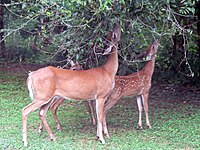
Photo from wikipedia
Reciprocal coevolutionary changes in predation and anti-predator behaviours have long been hypothesized, but evolutionary-scale evidence is rare. Here, we reconstructed the evolutionary-scale changes in the diel activity patterns of a… Click to show full abstract
Reciprocal coevolutionary changes in predation and anti-predator behaviours have long been hypothesized, but evolutionary-scale evidence is rare. Here, we reconstructed the evolutionary-scale changes in the diel activity patterns of a predator-prey system (carnivorous and herbivorous mammals) based on a molecular phyloecological approach, providing evidence of long-term antagonistic coevolutionary changes in their diel activities. Our molecular reconstruction of diel activity patterns, which is supported by morphological evidence, consistently showed that carnivorous mammals were subjected to a shift from diurnality to nocturnality, while herbivorous mammals experienced a shift from nocturnality to diurnality during their evolutionary histories. A shift in the diel activity of the herbivores as a result of carnivore avoidance is hypothesized based on molecular, morphological and behavioural evidence, and our results suggest an evolutionary-scale arms race of diel activity shifts between carnivorous and herbivorous mammals.
Journal Title: Scientific Reports
Year Published: 2018
Link to full text (if available)
Share on Social Media: Sign Up to like & get
recommendations!